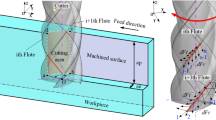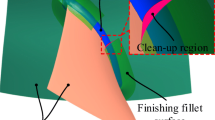Abstract
Cavity corner is one of the most common machining features in the complex structural components of aircraft, and processing pocket corner by plunge milling has the advantages of higher metal removal rate, smaller machining distortion, and higher machining precision, and especially is suitable for cavity corner machining with large depth. However, there are some problems in current corner plunge milling approach, such as sidewall over-cut, invalid tool location points, and uncontrollable residual height. Therefore, a universal layering algorithm for plunge milling tool path generation is projected and established. First, define and represent two-dimensional corner model. Next, the terminologies about machining layer circle, cutter circle, and cuspidal point circle are introduced and layering model is built. Then, construct cutter circle arrangement program on the basis of the intersection between layer circle and corner model. Meanwhile, the relationship between residual height and layering model is determined. Finally, the layering tool path is recursively generated in line with radial cutting width. Two groups of contrast experiments prove effectively that the proposed method excels the conventional methods in guaranteeing residual height and avoiding invalid tool location points. In addition, the layering method can maintain an efficient processing tool path ratio of more than 80%. Furthermore, the application of a CAD solid model of an aircraft panel demonstrates the feasibility and effectiveness of the layering approach.
Similar content being viewed by others
References
Wei Z, Wang M, Han X (2010) Cutting forces prediction in generalized pocket machining. Int J Adv Manuf Technol 50(5):449–458
Banerjee A, Feng H, Bordatchev E (2011) Process planning for corner machining based on a looping tool path strategy. Proc Inst Mech Eng Part B-J Eng 225(9):1578–1590
Rahman A, Feng H (2013) Effective corner machining via a constant feed rate looping tool path. Int J Prod Res 51(6):1836–1851
Aggarwal S, Xirouchakis P (2013) Selection of optimal cutting conditions for pocket milling using genetic algorithm. Int J Adv Manuf Technol 66(9):1943–1958
Liu X, Ding Y, Yue C, Zhang R, Tong X (2016) Off-line feedrate optimization with multiple constraints for corner milling of a cavity. Int J Adv Manuf Technol 82(9):1899–1907
Zhou M, Zheng G, Chen S (2016) Identification and looping tool path generation for removing residual areas left by pocket roughing. Int J Adv Manuf Technol 87(1):765–778
Sui S, Li Y, Shao W (2016) Tool path generation and optimization method for pocket flank milling of aircraft structural parts based on the constraints of cutting force and dynamic characteristics of machine tools. Int J Adv Manuf Technol 85(5):1553–1564
Held M, Spielberger C (2009) A smooth spiral tool path for high speed machining of 2d pockets. Comput Aided Des 41(7):539–550
Bouard M, Pateloup V, Armand P (2011) Pocketing toolpath computation using an optimization method. Comput Aided Des 43(9):1099–1109
Xu J, Sun Y, Zhang X (2013) A mapping-based spiral cutting strategy for pocket machining. Int J Adv Manuf Technol 67(9):2489–2500
Lin Z, Fu J, Shen H, Yao X (2015) Smooth contour-parallel tool path generation for high-speed machining through a dual offset procedure. Int J Adv Manuf Technol 81(5):1233–1245
Li X, Liang J, Ni P, Wang Y, Song Y, Tong L (2014) Novel path generation algorithm for high-speed pocket milling. Int J Prod Res 52(2):397–404
Liu Z, Li X, Song Y, Yi B, Chen F (2016) Lofting-based spiral tool path generation algorithm for milling a pocket with an island. Int J Adv Manuf Technol. doi:10.1007/s00170-016-8951-3
Chan K, Choy H (2002) Machining tactics for interior corners of pockets. Int J Adv Manuf Technol 20(10):741–748
Choy H, Chan K (2003) A corner-looping based tool path for pocket milling. Comput Aided Des 35(2):155–166
Wu S, Zhao Z, Wang C, Xie Y, Ma W (2016) Optimization of toolpath with circular cycle transition for sharp corners in pocket milling. Int J Adv Manuf Technol 86(9):2861–2871
Pateloup V, Due E, Ray P (2004) Corner optimization for pocket machining. Int J Mach Tools Manuf 44(12–13): 1343–1353
Zhao Z, Wang C, Zhou H, Qin Z (2007) Pocketing toolpath optimization for sharp corners. J Mater Process Tech 192:175–180
Chen Z, Abdelkhalek S (2014) A new approach to planning plungers paths for efficient 21/2-Axis computer numerically controlled plunge milling of complex pockets with islands. J Manuf Sci Eng 136(4):041013–041019
El-Midany T, Elkeran A, Tawfik H (2006) Optimal CNC plunger selection and toolpoint generation for roughing sculptured surfaces cavity. J Manuf Sci Eng. doi:10.1115/1.2280873
Sun C, Wang Y, Huang N (2015) A new plunge milling tool path generation method for radial depth control using medial axis transform. Int J Adv Manuf Technol 76(9):1575–1582
Yang S (2014) Research and application of plunge milling technology. Metal Working(Metal Cutting) (20): 24–27
Wakaoka S, Yamane S, Sekiya K, Narutaki N (2002) High-speed and high accuracy plunge cutting for cutting for vertical walls. J Mater Process Tech 127:246–250
Liu S, Cui Y, Peng Y (2013) Research on NC milling processing and programming of corner feature in aircraft structural parts. Manuf Technol Mach Tool 11:95–100
Tawfik H (2006) A new algorithm to calculate the optimal inclination angle for filling of plunge-milling. Workers’ University, Dissertation
Author information
Authors and Affiliations
Corresponding author
Ethics declarations
Conflict of interest
The authors declare that they have no conflict of interest.
Rights and permissions
About this article
Cite this article
Shi, Y., Zheng, G. The algorithm of layering calculation for corner plunge milling tool path. Int J Adv Manuf Technol 91, 2059–2075 (2017). https://doi.org/10.1007/s00170-016-9942-0
Received:
Accepted:
Published:
Issue Date:
DOI: https://doi.org/10.1007/s00170-016-9942-0




